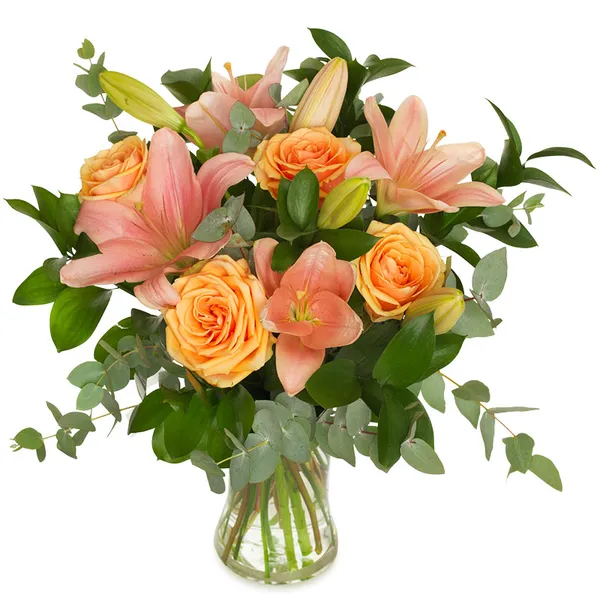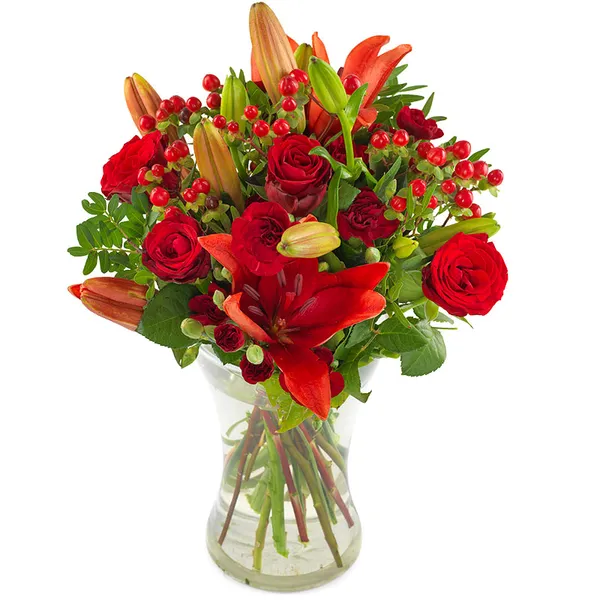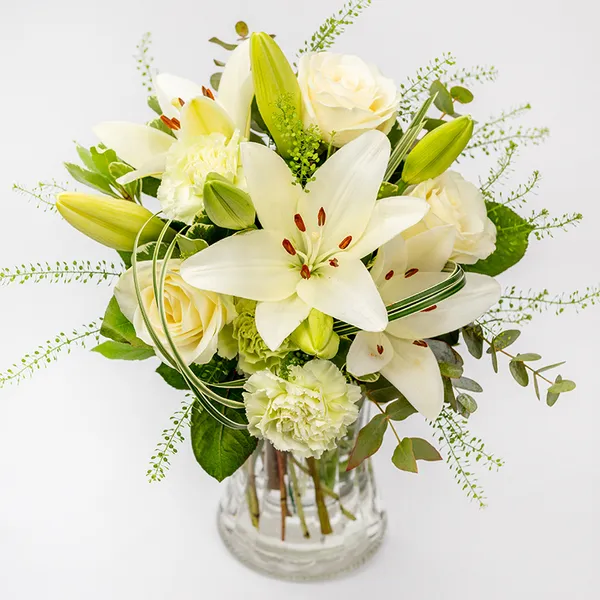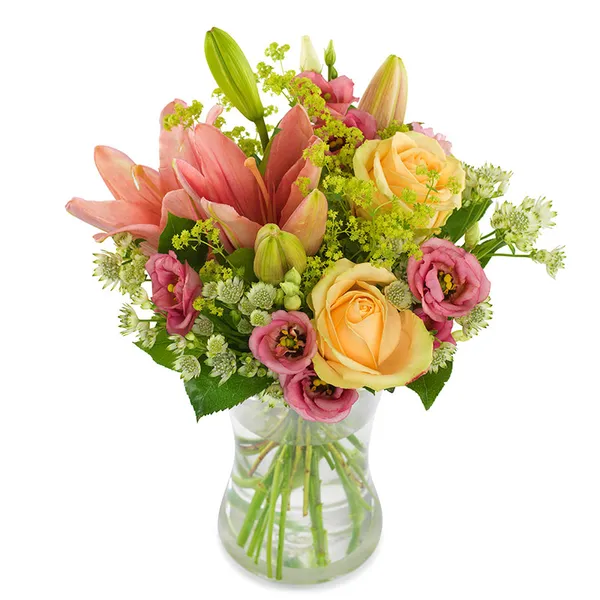Lily: The Elegant and Versatile Bloom
Lilies are among the most iconic and elegant flowers, cherished for their large, trumpet-shaped blooms and captivating fragrance. Thanks to their striking appearance, lilies are oftentimes the eyecatcher of floral arrangement. They are symbols of purity, renewal, and devotion, making them a popular choice for weddings, religious ceremonies, and sympathy arrangements. Their diverse types range from the classic Easter Lily to the bold Asiatic and Oriental hybrids, each offering unique characteristics.
COMMON NAME
Lily
BOTANICAL NAME
Lilium spp.
ORIGIN
Northern Hemisphere (Asia, Europe, North America)
PEOPLE ALSO CALL IT
Day lily, Easter lily
FLOWERING TIME
Summe (June to August)
ASPECT
Full sun to partial shade
SYMBOLISM
Purity, renewal, devotion, passion
Care Tips for Cut Lilies in a Vase
Lilies have long, upright stems, so they need a deep vase to accommodate their height. A short, wide vase will not adequately support them. Look for a narrow vase that lets the buds open gracefully without restriction.
Clean the Vase
Wash and rinse your vase to remove any bacteria or dust that might contaminate the water and block water flow into the stems.
Remove Foliage Below the Water Line
Leaving leaves sitting in the water will shorten the vase life of your lilies. Carefully strip off any leaves falling below the water line before placing the stems, paying attention to the lower part of the stem, where leaves are the densest.
Cut the Stems at an Angle
Trim each lily stem at a 45-degree angle with a blade or shears to allow more surface area for the stem to absorb water and remove any leaves or secondary buds that would sit below the water line in your arrangement.
Fill the Vase with Lukewarm Water
Lilies do best when hydrated with lukewarm water, which moves up the stems faster than cold water. Fill your cleaned vase about halfway with lukewarm water before arranging the lilies. The water level should reach about 2-3 inches below the stem ends. Too little water will lead to dehydration and wilting. Too much can leave foliage submerged.
Add Your Flower Preservative
Flower preservative is essential for keeping cut flowers like lilies fresh longer. The preservatives inhibit bacterial growth and provide nutrients to the blooms. Use the correct amount for the volume of water per the product directions.
Place Your Lilies in a Dry, Cool Spot
Once arranged in the vase, display your lilies away from direct sunlight and away from heat sources like appliances or heating vents.
Replace the Water Every Two Days
Over time, the water in your vase will develop bacterial growth. Freshening the water every other day gives your lilies a new water source. You can also retrim the stems by about half a centimetre each time to expose fresh parts that can take up water.
Common Types of Lilies
Asiatic Lilies
Asiatic lilies are shorter plants under 3 feet tall. They bloom in early summer with 3-6 flowers per stem. Colours include red, yellow, white, pink, and orange. Most lack fragrance but have beautifully coloured blossoms.
'Netty's Pride' has deep purple petals fading to white tips, facing upward on 2–3-foot stems. 'Rosella's Dream' bears pink blooms with cream throats. For dark drama, 'Night Rider' has nearly black petals. 'Starlette' combines red and orange. 'Enchantment' has vivid orange petals with spots.
Smaller dwarf varieties like 'Orange Pixie' and 'Denia Pixie' reach just 8-18 inches with abundant colour. Asiatic lilies work well in bouquets and as accent plants.
Oriental Lilies
Oriental lilies are intensely fragrant, blooming in midsummer. Flowers nod downward and may be spotty. Plants reach 2-4 feet tall.
Popular varieties include 'Casa Blanca' with large white blooms, 'Muscadet' in creamy white with pink markings, and pink 'Magic Star'. 'Tiger Moon' combines cream, yellow, and red.
These make excellent cut flowers, releasing scent into arrangements. The large blooms also stand out in gardens.
Longiflorum Lilies
Longiflorum lilies are commonly called Easter lilies. They produce elegant white trumpet-shaped blooms on 2–4-foot stems in summer.
'White Heaven' has pure white trumpets with yellow throats. 'White American' is a tougher hybrid with orange anthers – ideal for floral weddings and events.
The Easter lily traces its origins to the Ryukyu Islands of Japan, with Lilium Longiflorum bulbs brought from the Ryukyu Islands to the United States.
At first, the temperamental lilies did not thrive in the U.S. climate. After years of effort, Louis Houghton was the first to force the lilies into bloom around Easter in 1919.
LA Hybrids
LA hybrids combine traits of Asiatic and Longiflorum lilies. They lack fragrance but produce vividly coloured, upright-facing flowers on tall stems.
'Corleone' has bright red blooms with orange shading on 4-foot stems. 'Big Brother' bears huge 10-inch white and yellow flowers on 5-foot plants. 'Forza Red' has a bold, solid red colour on thick stems. These make stunning focal point cut flowers.
Trumpet Lilies
Trumpet lilies have large, intensely fragrant flowers in summer, with the blooms facing outward on upright 2–6-foot stems.
'Regale' is known for elegant white blooms with pink and yellow. 'African Queen' bears huge orange blooms with tropical appeal. 'Golden Splendour' lives up to its name with golden yellow petals. The 'Pink Perfection' group offers bright pink or purple options.
The powerful scent makes trumpet lilies ideal for cut flower arrangements and perfumed gardens alongside smaller flowers like gerbera daisies.
Stargazers
First introduced in the 1970s, these blooms face upward, displaying their vibrant colours with striking crimson and pink with tiny white edges. A dusting of reddish spots adorns the centre of each flower, which can reach up to 6 inches across.
Their vivid colour makes them stand out in floral arrangements. Stargazer lilies also emit a lovely scent, filling any space with their fragrance.
Martagon Lilies
Martagon or Turk's cap lilies produce nodding flowers in summer on very tall 4–6-foot stems. Colours include red, yellow, orange, pink, and white, sometimes with spots.
'Dalhansonii' is a popular antique variety with honey-coloured blooms. The profuse flowers and height make martagon lilies ideal back-row plants for borders and cutting gardens.
Canada Lilies
Native Canadian lilies thrive in the shade with pendant flowers in yellow and orange. Plants reach 2-4 feet tall with whorled leaves and 5-20 blooms per stalk.
This versatile North American native adds its own charm to wooded gardens and arrangements. The nodding flowers and cool colours stand out.
Consider bloom time, colour, height, fragrance, and direction when choosing lilies. With so many classics, finding the perfect lilies for floral designs is easy.
Meaning of Different Lily Types
Lilies are such elegant flowers with their trumpet-shaped blooms on their tall, slender stems having a majestic aura. But each type of lily has a special meaning based on its colour and look. Take the classy white Calla Lily. It's all about purity and holiness. No wonder it shows up in paintings of the Virgin Mary so often!
Then you've got the bold orange tiger lily representing confidence and prosperity. Pink stargazers are said to mean abundance, while red lilies scream passion. And how cool are black lilies, with their deep burgundy colour symbolising rebirth? There are loads more, too.
Sunny yellow lilies stand for joy, pinkish and purple Asiatics for femininity, the trumpet-blowing Easter lily for new beginnings - lilies really cover it all. Even multi-colour lilies like the red and yellow Brindisi lily can signify friendship.
With all the different hybrids out there now, the options are endless. A ruffly pink Rosato lily whispers refinement, while the two-toned Two Face mixes scarlet and yellow for an upbeat vibe ideal for thank you and get-well-soon flowers.
Frequently Asked Questions About Lilies
Lilies (Lilium species) typically bloom from spring to late summer, depending on the type:
Asiatic lilies: Early to mid-summer
Oriental lilies: Mid to late summer
Trumpet lilies: Mid-summer
Daylilies: Throughout summer with repeat blooms in some varieties
The timing can vary based on the climate and growing conditions.
Lilies expert Raymond Vijverberg, experienced lily grower and co-owner of Qualily lily farm, however, mentions that lilies can be bought all year round and that cultivation time in the greenhouse is about 11 weeks.
Yes, lilies are extremely toxic to cats. Even small exposures, such as ingesting pollen, licking the petals, or chewing leaves, can cause severe kidney failure or death in cats. This includes many types of lilies like Easter lilies, Asiatic lilies, and Oriental lilies.
If a cat has been exposed, seek immediate veterinary care.
While lilies are less toxic to dogs than cats, some varieties can still cause gastrointestinal upset if ingested. Peace lilies and Calla lilies, which are not true lilies, contain insoluble calcium oxalates and can irritate the mouth and throat.
True lilies like Easter lilies may cause more severe symptoms, so consult a veterinarian if ingestion occurs.
Some lilies are mildly toxic to humans, especially if ingested. The symptoms can include nausea, vomiting, or stomach pain. The bulbs of certain species, like Tiger lilies and Glory lilies, are particularly toxic if consumed in large quantities.
The pollen of lilies can also cause skin irritation in some individuals, so handling with care is recommended.
Lily expert Raymond Vijverberg from the Qualily lily farm advises the following:
Deadhead the Flowers: Remove spent blooms to prevent seed production and conserve the plant's energy for bulb growth.
Keep the Leaves: Allow the foliage to naturally yellow and die back. This helps the bulb store energy for the next blooming cycle.
Reduce Watering: Once the foliage has died back, reduce watering significantly to allow the soil to dry out.
Did you know lilies have been cherished for thousands of years worldwide? Over 100 different species are transcending the ages.
The ancient Egyptians were huge fans. They associated white lilies with their goddess Hathor, a symbol of fertility and rebirth. The Egyptians loved lilies so much that they painted them on tombs - they thought lilies meant there was life after death!
Christianity embraced the lily with the Virgin Mary. In artistic depictions, the angel Gabriel holds out a lily when he visits Mary to tell her she'll give birth to Jesus. Lilies are all over images of Mary and Jesus, emphasising Mary's purity as the mother of Christ.
In Chinese culture, golden yellow and orange spotted lilies symbolise summer, abundance, and prosperity. White lilies are traditional funeral flowers.
Lilies carry deep symbolism, often varying by colour:
White lilies: Purity, innocence, and renewal; commonly used in weddings, baptisms and funerals.
Pink lilies: Admiration and compassion; ideal for Valentine's Day and first dates.
Yellow lilies: Happiness, gratitude, joy, and pride; perfect for graduations.
Red lilies: Passion and love, perfect for your significant other.
Orange lilies: Confidence and energy
In various cultures, lilies symbolise rebirth and transformation, and they are associated with beauty and spirituality.
The key to long-lasting lilies is using a clean vase, changing the water frequently, keeping them in a cool spot and usingfloral food. Recut the stems every few days for better water uptake, and don't let any foliage sit in the water.
Lilies last 7-12 days in a vase, with wilting and browning usually occurring by day eight. However, this depends on several factors.
First, the variety of lilies makes a difference. Some hybrid lilies, like Asiatics, wilt quickly, while others, like LA hybrids, can look lovely for up to two weeks.
Second, the maturity of the blooms when cut impacts their longevity. Lily buds just about to open will generally last longer than flowers cut in full bloom – that's why we always send our lilies in the bud.
Third, environmental conditions play a role, with warm, dry air and direct sunlight tending to shorten a lily's vase life. Cool, humid conditions prolong it.
Finally, proper care practices can dramatically extend the time lilies remain vibrant after cutting. Proper handling and nourishment can double or even triple how long cut lilies last in a vase, giving you up to two weeks of joy.
When putting lilies in a vase, you'll want to use the right water level to keep them looking beautiful for longer. Fill the vase halfway so the stem ends are covered by water. For slim vases, that's usually enough. Refrain from overfilling since too much water can make the stems rot.
Change the water every 2-3 days, cutting the stems again and removing leaves below the water line. You'll want to use less water each time you trim the stems and sprinkle in a little more flower preservative for the best results.



